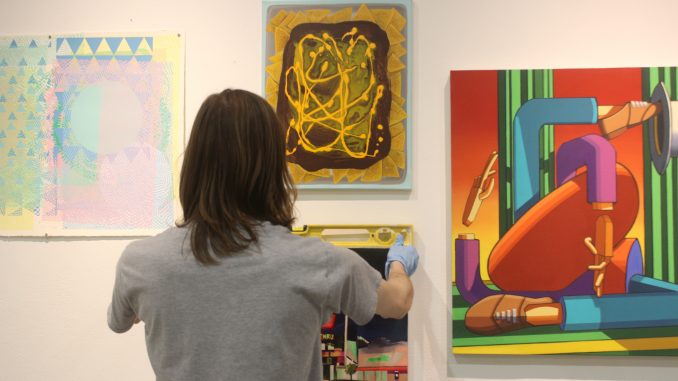
Jonathan Dedecker took multiple trips up and down elevators in the Tyler School of Art with trolley carts carrying FedEx boxes. The boxes were labeled “fragile” and postmarked from places as far away as Los Angeles and Stockholm.
The second-year fine arts master’s student curated the exhibit “Ocotillo,” which features nearly 100 works from artists across the country and world. The opening reception is this Friday in the Stella Elkins Tyler Gallery in the Tyler School of Art. There will be music and performance pieces during the reception.
This is Dedecker’s first curated exhibit at Temple before he graduates in May. Though he has curated shows before, this one is on a larger scale, he said.
Dedecker added that being in several exhibits with other artists he admires, like a larger exhibit in San Luis Obispo, California by artists Ryan Travis Christian and Travis Fish, pushed him to curate a large group show on his own.
“I had met a lot of people throughout my undergrad and graduate experience so I wanted to try and include a lot of people,” said Dedecker, who has a concentration in painting. “Initially, it started because I wanted to bring together a bunch of people whose work I really admire and bring it all into the same space.”
Dedecker said he has been trying to curate an exhibit at the school for a year, and he received the approval from Tyler to start planning in August 2016.
There’s no theme for Dedecker’s show, because he prefers to leave the exhibit “open-ended,” he said, and allow more freedom for the artists.
“Personally for me, the way that I like to participate in shows is when the imagery isn’t dictated by a theme.”
Although the exhibit is mostly paintings, it also includes ceramics and sculptures.
Dedecker said based on the amount of wall space in the gallery, he felt more comfortable with curating more paintings.
“I knew that from the get-go because I was familiar with the space,” he said, “It was mainly painting because I primarily paint and I wanted to see paintings, talk about paintings and hopefully bring painters here.”
The name of the exhibit, “Ocotillo,” comes from his roots as an Arizona native. An ocotillo is a large, cactus-like desert shrub and he had one in his childhood home backyard.
“It’s this plant that spreads out and when it rains it quickly grows these four-centimeter leaflets,” Dedecker said. “I just could see that in my brain and have it be a part of this large group show, expanding and sort of giving it an opportunity to grow.”
Dedecker said he also faced the issue that his opening reception is Jan. 20, the day of President-elect Donald Trump’s inauguration. Several local galleries are closing for the day in protest of his inauguration.
But Dedecker said he feels people should be showing their work to protest, rather than having a day of silence.
“I feel like having this show with a lot of people will bring a lot of artists together,” he said. “People want to actually talk about things because the whole idea about art is not just to talk about the work, but to see what other sort of conversations diverge from the individual pieces.”
Although the exhibit is not thematically curated, Dedecker said his own artistic interests and influences, like usage of color, cartoons and comics, played a role in his decisions.
Some of the artists include New York-based David Humphrey, Don Pablo Pedro and Tyler professors Matthew Sepielli, Susan Moore and Marilyn Holsing.
Sepielli, a painting professor, will display his 16-by-20-inch oil-on-canvas painting, “Cluster.” The abstract painting references science fiction, he said.
“It is very layered,” Sepielli said. “I have been thinking a lot about science fiction and how people develop ideas in science fiction, and that seemed to me to be like a parallel to how artists develop ideas.”
He added that the large exhibit will increase dialogue and give notice to the Tyler School of Art.
“Those artists have a reason, coming internationally, even more of a reason to learn about Tyler,” Sepielli said. “It basically creates a network. You find an artist you like in Stockholm and you wonder who the artist is regularly showing with and it gives students and faculty opportunities to do research on the artists we are showing alongside.”
Dedecker added that the exhibit was an “experiment” for future large shows he may curate.
“I think it is really just to develop relationships between the work and to do a large show is to really dive into painting and talk about painting,” he said. “It is not even to make connections between the works, it’s just to see them as a whole.”
Emily Scott can be reached at emily.ivy.scott@temple.edu or on Twitter @emilyivyscott.


Be the first to comment